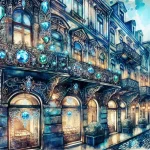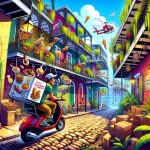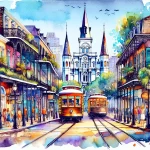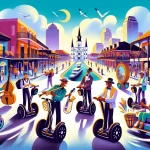New Orleans’ French Quarter is a captivating cultural hub that draws millions of visitors each year with its storied history, striking architecture, lively music scene, and world-renowned cuisine. This iconic neighborhood offers an unparalleled experience that immerses you in the city’s unique blend of French, Spanish, Creole, and Cajun influences.
In This Article
TL;DR
- The French Quarter boasts a wealth of cultural attractions, architectural gems, and a lively atmosphere.
- Key highlights include Jackson Square, Royal Street, the French Market, Preservation Hall, ghost tours, iconic restaurants, and picturesque courtyards and balconies.
- Exploring the area on foot is recommended, and visitors should prepare for crowds, especially during festivals and events.
Introduction to the French Quarter: A Cultural Hub
The French Quarter, also known as the Vieux Carré, is the oldest neighborhood in New Orleans, founded in 1718. This historic district is renowned for its colorful buildings with wrought-iron balconies, cobblestone streets, and lively atmosphere that captures the essence of New Orleans’ joie de vivre.
Jackson Square: The Heart of the French Quarter
Jackson Square is the cultural and historical heart of the French Quarter. This iconic square, originally known as the Place d’Armes, dates back to the 1720s and is surrounded by some of the city’s most significant landmarks.
The St. Louis Cathedral, with its towering spires and stunning facade, is the centerpiece of Jackson Square. Adjacent to the cathedral are the Cabildo and the Presbytère, two historic buildings that now house museums dedicated to the city’s rich history and culture.
Jackson Square is also a hub for artists and street performers, who add to the vibrant atmosphere with their music, art, and entertainment. Visitors can admire the works of local artists, watch talented musicians perform, or even have their portrait sketched by a talented caricaturist.
Royal Street: A Stroll Through Art and Antiques
Royal Street is a must-visit destination for art lovers and antique enthusiasts. This iconic street, stretching from Canal Street to Esplanade Avenue, is lined with art galleries, antique shops, and boutiques that showcase the best of New Orleans’ creative talent.
One of the highlights of Royal Street is M.S. Rau Antiques, a renowned gallery that houses an impressive collection of fine art, antiques, and rare collectibles. Other notable galleries include the Callan Contemporary, which features works by local and international artists, and the Rodrigue Studio, dedicated to the iconic Blue Dog paintings of George Rodrigue.
Visitors can spend hours browsing the unique offerings of Royal Street, from intricate jewelry and handcrafted pottery to vintage furniture and rare books. It’s a treasure trove for those seeking authentic New Orleans souvenirs or simply appreciating the city’s artistic heritage.
The Bustling French Market: Food and Crafts
No visit to the French Quarter is complete without exploring the iconic French Market. This open-air market, dating back to 1791, is a vibrant hub of local food, crafts, and souvenirs.
The French Market is a paradise for foodies, offering a variety of local delicacies such as beignets, po-boys, gumbo, and pralines. Visitors can sample fresh seafood, indulge in Creole and Cajun specialties, or simply sip on a refreshing cocktail while soaking in the lively atmosphere.
In addition to food, the French Market is a haven for shoppers seeking unique crafts and souvenirs. Local artisans showcase their handmade jewelry, pottery, paintings, and more, providing visitors with the opportunity to take home a piece of New Orleans’ rich cultural heritage.
Preservation Hall: Keeping Jazz Alive
Preservation Hall is a must-visit destination for music lovers, particularly those with an appreciation for traditional New Orleans jazz. This iconic venue, located in the heart of the French Quarter, has been a cornerstone of the city’s jazz scene since its founding in 1961.
Stepping into Preservation Hall is like stepping back in time. The intimate setting, with its weathered walls and simple benches, creates an authentic atmosphere that allows visitors to fully immerse themselves in the music. The hall hosts nightly performances by some of the city’s most talented jazz musicians, who keep the spirit of New Orleans jazz alive through their passionate performances.
Preservation Hall not only offers an unforgettable musical experience but also plays a vital role in preserving and promoting the city’s rich jazz heritage. Visitors can attend educational programs and workshops, ensuring that the legacy of New Orleans jazz continues to thrive for generations to come.
Haunted History: Ghost Tours and Legends
With its rich history and centuries-old buildings, it’s no surprise that the French Quarter is rumored to be one of the most haunted neighborhoods in the United States. Ghost tours have become a popular attraction, offering visitors a unique way to explore the area’s spooky past.
Several companies offer guided ghost tours, taking visitors on a journey through the French Quarter’s most haunted locations. From the infamous LaLaurie Mansion, where unspeakable horrors took place, to the haunted hotels and cemeteries, these tours provide a chilling glimpse into the city’s dark history and supernatural legends.
Whether you’re a believer in the paranormal or simply seeking a thrilling experience, a ghost tour in the French Quarter is sure to send shivers down your spine and leave you with unforgettable tales of New Orleans’ haunted past.
Culinary Delights: Iconic Eateries and Local Dishes
New Orleans is renowned for its rich culinary heritage, and the French Quarter is home to some of the city’s most iconic restaurants and local dishes. From classic Creole and Cajun fare to contemporary twists on traditional flavors, the neighborhood offers a gastronomic adventure for every palate.
Establishments like Galatoire’s, Arnaud’s, and Brennan’s have been serving up legendary dishes for over a century, offering visitors a taste of New Orleans’ culinary history. These iconic restaurants are known for their signature dishes, such as Oysters Rockefeller, Bananas Foster, and Baked Alaska.
For a more casual dining experience, visitors can indulge in local favorites like po-boys, gumbo, jambalaya, and beignets at legendary spots like Johnny’s Po-Boys, Café du Monde, and Central Grocery, home of the famous muffuletta sandwich.
No matter where you dine in the French Quarter, you’re sure to experience the flavors and traditions that have made New Orleans a culinary mecca.
Courtyard and Balcony Architecture: A Visual Tour
One of the most striking features of the French Quarter is its stunning courtyard and balcony architecture. These architectural elements, influenced by French, Spanish, and Caribbean styles, create a visually captivating atmosphere that transports visitors back in time.
Many of the historic buildings in the French Quarter feature beautiful courtyards, often adorned with lush gardens, fountains, and wrought-iron details. These hidden oases provide a peaceful respite from the bustling streets and offer a glimpse into the city’s rich cultural heritage.
The iconic balconies, with their intricate ironwork and colorful shutters, are another defining feature of the French Quarter’s architecture. These balconies not only add charm and character to the buildings but also serve as a reminder of the city’s Spanish and French colonial influences.
Visitors can admire these architectural marvels by taking a guided walking tour or simply strolling through the neighborhood’s picturesque streets, marveling at the intricate details and unique styles that make the French Quarter a true architectural gem.
Festivals and Events: Celebrating New Orleans Style
The French Quarter is the epicenter of New Orleans’ vibrant festival scene, hosting a variety of events throughout the year that celebrate the city’s rich culture, music, and culinary traditions.
Mardi Gras, the world-famous carnival celebration, is undoubtedly the most iconic event held in the French Quarter. This annual extravaganza features colorful parades, elaborate costumes, and a lively atmosphere that captures the spirit of New Orleans.
Other notable festivals include the French Quarter Festival, a free event showcasing local music, food, and culture; the New Orleans Jazz & Heritage Festival, a celebration of the city’s jazz heritage; and the Voodoo Music + Arts Experience, a multi-day festival featuring a diverse lineup of music, art, and cultural experiences.
These festivals not only provide visitors with an opportunity to immerse themselves in the city’s unique traditions but also play a vital role in preserving and promoting New Orleans’ cultural identity.
Practical Tips for Visitors
To make the most of your visit to the French Quarter, it’s essential to plan ahead and follow some practical tips:
Transportation: While the French Quarter is best explored on foot, visitors can also take advantage of the city’s public transportation system, including streetcars and buses. Taxis and ride-sharing services are also readily available.
Safety: As with any major tourist destination, it’s important to exercise caution and be aware of your surroundings, especially at night. Stick to well-lit areas and avoid carrying excessive amounts of cash or valuables.
Accommodations: The French Quarter offers a wide range of accommodations, from historic hotels to charming bed and breakfasts. Book well in advance, especially during peak seasons and festivals.
Best times to visit: While New Orleans is a year-round destination, the spring and fall months offer milder weather and fewer crowds. However, if you’re interested in experiencing the city’s iconic festivals, plan your visit accordingly.
By following these tips and immersing yourself in the rich culture and history of the French Quarter, you’re sure to have an unforgettable experience in one of the most vibrant and captivating neighborhoods in the world.






